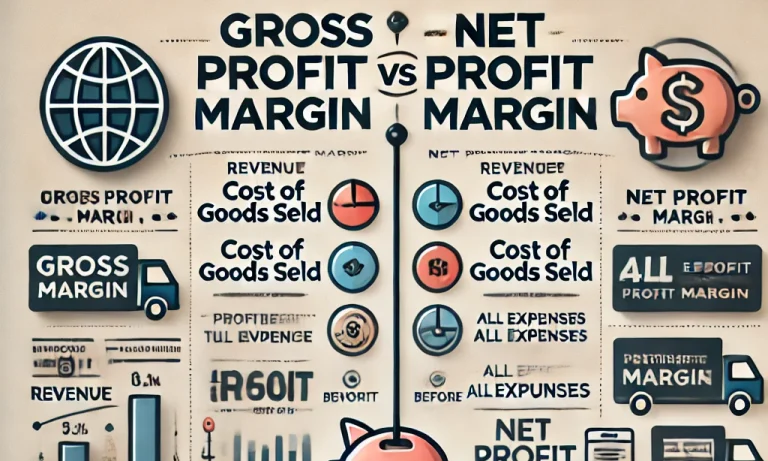The difference between gross profit margin and net profit margin is crucial for understanding a company’s profitability. These two metrics are among the key financial indicators used to appraise the business’s financial health and operational efficiency. The gross profit margin calculates profit after deducting costs directly attributed to revenues; meanwhile, the net profit margin computes profit after deducting all kinds of expenses, such as taxes and interest. The explanation of both metrics in this article reveals the differences between them, their importance, and how they influence decision-making.
What is Gross Profit Margin?
Gross profit margin is the percentage of revenue remaining after deducting the cost of goods sold (COGS). It reflects a company’s ability to generate profit from its core production or trading activities, excluding indirect expenses.
The formula for Gross Profit Margin
Where: Gross Profit = Revenue – Cost of Goods Sold (COGS)
Example: A company earns revenue of ₹10,00,000, with a COGS of ₹6,00,000.
Gross Profit = ₹10,00,000 – ₹6,00,000 = ₹4,00,000
Gross Profit Margin = (₹4,00,000/₹10,00,000)×100=40%
Key Characteristics of Gross Profit Margin
Gross profit margin plays a vital role in evaluating a company’s operational efficiency and its ability to generate revenue from core activities. It is particularly useful for comparing performance within and across industries.
- Focuses on Direct Costs Only: Gross profit margin considers only the direct costs associated with producing goods or services. These costs include raw materials, labor, and manufacturing expenses directly tied to the production process. This narrow focus helps businesses pinpoint areas where they can improve cost efficiency in production.
- Indicates Operational Efficiency: Gross profit margin directly reflects how efficiently a company manages production and inventory costs. Companies use this metric to assess their ability to maintain profitability in their core operations.
- Varies by Industry Benchmarks: Gross profit margin varies widely across industries due to differences in cost structures and operational models. Businesses in high-margin industries like software may have significantly different benchmarks compared to those in low-margin sectors like retail.
What is Net Profit Margin?
Net profit margin is the percentage of revenue remaining after all expenses, including operating costs, taxes, interest, and COGS, have been deducted. It provides a comprehensive view of a company’s overall profitability.
The formula for Net Profit Margin
Where: Net Profit = Total Revenue – (COGS + Operating Expenses + Taxes + Interest)
Example: A company earns revenue of ₹10,00,000, incurs COGS of ₹6,00,000, operating expenses of ₹2,00,000, and pays ₹1,00,000 in taxes.
Net Profit = ₹10,00,000 – (₹6,00,000 + ₹2,00,000 + ₹1,00,000) = ₹1,00,000
Net Profit Margin = (₹1,00,000/₹10,00,000)×100=10%
Key Characteristics of Net Profit Margin
It shows how much profit the company retains from each rupee of revenue after covering all expenses. This metric helps stakeholders understand whether the business is operating sustainably and profitably.
- Includes All Expenses: Net profit margin includes every expense a business incurs during operations. It accounts for administrative costs, interest payments, taxes, and depreciation. By considering these elements, it provides a comprehensive view of how well the company manages its overall expenditures.
- Measuring Overall Profitability: This scale measures net profit margin, defined as the percentage of revenue that turns into a profit. It consequently shows how much profit the business retains for every rupee earned. The higher it is, the better profitability and efficient cost management are. Lower margins indicate what needs improvement.
- Reflects Financial Health: The inability to yield good margins consistently means high operational costs or inefficiency in resource management. Companies holding good net profit margins portray resilience and growth ability, so it is important to analyze companies on this parameter regarding long-term viability.
Key Differences Between Gross Profit Margin & Net Profit Margin
The gross profit margin vs net profit margin comparison reveals their unique roles in financial analysis. Below are five key differences:
Definition
- Gross Profit Margin: Gross profit margin shows how much revenue remains after deducting the cost of goods sold (COGS). It directly measures the profitability of core operations and reflects production and sales efficiency.
- Net Profit Margin: Net profit margin calculates the remaining revenue after subtracting all expenses, including operating costs, taxes, and interest. This measure evaluates overall profitability and financial health.
Focus
- Gross Profit Margin: Gross profit margin focuses on the efficiency of managing direct costs in core activities like production and sales. It highlights how effectively the business generates profit from its primary operations.
- Net Profit Margin: Net profit margin focuses on overall profitability. It includes all costs and provides a complete picture of the company’s ability to generate profit across all functions.
Formula
- Gross Profit Margin:
- Net Profit Margin:
Expenses Considered
- Gross Profit Margin: Gross profit margin only considers direct costs related to goods and services production, such as materials and labor. It excludes other operational or administrative expenses.
- Net Profit Margin: Net profit margin accounts for all expenses, including indirect costs, taxes, depreciation, and interest. It gives a complete view of the business’s profitability.
Scope
- Gross Profit Margin: Gross profit margin focuses specifically on production and sales efficiency. It measures how well the company controls costs to maximize revenue from core operations.
- Net Profit Margin: Net profit margin provides a broader perspective. It evaluates profitability after accounting for all costs, helping stakeholders understand the company’s overall financial health.
| Aspect | Gross Profit Margin | Net Profit Margin |
| Definition | Revenue minus COGS as a percentage of revenue. | Revenue minus all expenses as a percentage of revenue. |
| Focus | Operational efficiency of core activities. | Overall profitability after all costs. |
| Formula | (Gross Profit/Revenue)×100 | (Net Profit/Revenue)×100 |
| Expenses Considered | Only direct costs (COGS). | All expenses, including taxes and interest. |
| Scope | Specific to production and sales. | Comprehensive view of financial health. |
Conclusion
The scope and focus of gross profit margin and net profit margin differ. Gross profit margin highlights operational efficiency, whereas net profit margin provides a holistic view of profitability. These two metrics are used together to ensure the optimization of costs, price fixing, and overall performance measures. Knowledge of roles and differences is necessary to better manage finance and make correct decisions.
Gross Profit Margin vs Net Profit Margin FAQs
What is the main difference between gross profit margin and net profit margin?
Gross profit margin focuses on direct costs, while net profit margin includes all expenses.
Why is net profit margin important?
It measures a company’s overall profitability and financial health.
Can a company have a high gross profit margin but a low net profit margin?
Yes, if operating expenses or taxes are significantly high.
How do gross profit margin and net profit margin complement each other?
Gross profit margin analyzes production efficiency, while net profit margin evaluates financial sustainability.
What are the ideal benchmarks for these metrics?
Benchmarks vary by industry, but consistent improvement is key.


